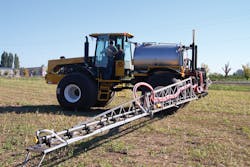Hydraulics makes sprayer nimble
Consistent travel speed is critical for mobile sprayers to efficiently apply expensive fertilizer or insecticides in farms and orchards. Designers of drives for these sprayers face a major challenge because they do not know what type of unpredictable terrain or surfaces the equipment will be used on. Consequently, drives must be designed for worst-case scenarios. Not only that, but a machine’s large fertilizer tank means the vehicle’s gross weight will be much greater at the start of a run than at the finish. The sprayer also must have a short turning radius, and it must be narrow enough to transport over the highway between working sites.
Smooth, high-torque propulsion
Engineers at GK Machine Inc., Donald, Oreg., took all these factors into consideration when they designed the Model 4W6 sprayer. This 6-ton machine — powered by a 155-hp, 6-cylinder Cummins diesel engine — is configured to accept the company’s 3-ton, dual-spinner dry box for spreading granular material or a tank and spray booms for liquids.
According to Charles Roper, of GK Machine, the 4W6 uses a 4-speed, full-time 4-wheel drive hydrostatic transmission designed for high traction. The engine drives a pair of 100-cc Sauer-Danfoss Series 90 pumps directly for propulsion. Each axial-piston pump drives a hydraulic motor in a closed hydrostatic circuit. The pumps’ over-center capability provides reverse rotation of wheels. A double-gear pump supplies the sprayer or spreader from its 29-cc/rev section, and steering and suspension circuits from its 22-cc/rev section.
Each Series 90 pump — fitted with optional traction valve cicuitry — supplies pressurized fluid to a pair of two-speed axial-piston motors from Bosch Rexroth. Each motor is installed in an Auburn Gear #8 planetary gear drive to transmit smooth, high-torque power to the wheels.
The hydraulic motors and planetary gear reduction form a single compact unit. The two-speed option for the motors provides higher ground speed and torque on demand. Each motor’s maximum displacement is 45 cc; the minimum (per GK’s specification) is 28 cc. A hydraulic piston changes the motor’s swashplate angle between maximum and minimum displacement.
The planetary gear drive ratio is 34:1. This ratio combines with the motor displacement adjustment to provide a maximum torque at the wheel of 58,000 lb-in. Conversely, at the minimum displacement, the ground speed for the 4W6 can be up to 20 mph for over-the-road travel.
Unconventional steering
Instead of using conventional steering, designers opted to articulate the machine’s frame for steering. This enables mounting oversize tires closer to the frame, which in turn produces a transportation width of less than 12 ft, although the steering still is relatively tight — with a 15-ft turning radius. The frame’s front end also can oscillate ±10° relative to the rear. The oscillating motion reduces stress on the frame and improves tire contact under all ground conditions.
The 4W6’s steering wheel actuates a Char-Lynn steering control unit from Eaton Hydraulics. This steering unit features Eaton’s Q-Amp variable ratio. With this feature, when the operator turns the steering wheel slowly, flow from the gear pump passes through a rotary valve into a gerotortype metering section, then to the steering cylinder. The metering action avoids any tendency to overcorrect. Furthermore, for quicker response at higher travel speeds, the steering control reacts to a faster-turning steering wheel by bypassing the metering section and sending more flow to the steering cylinder to rapidly change the vehicle’s direction.
In the cab, the operator sets travel direction and speed with a 2-way joystick. The same joystick also is fitted with toggle switches that control the sprayer-spreader functions. The pumps’ electronic displacement control that interfaces the joystick and the traction pump includes automatic ramping of acceleration and deceleration.
Other dashboard controls are: a push button to actuate a positraction valve (integral to the traction pump), which divides flow equally to all wheel motors; and range-control push buttons for the wheel motors. To accomplish 4-speed operation, the operator can set all motors in high range, two in high and two in low, or all motors in low range.
Hydropneumatic suspension
GK Machine’s 4W6 sprayer is fitted with a hydropneumatic suspension system that combines nitrogencharged accumulators and hydraulic suspension struts. This system can be set for automatic load-leveling in the field or it can be relaxed electrically to lower the entire machine for transportation. Sensors, connected to the axles, deliver position information to an onboard computer, which then adjusts the cylinder extension for optimal operating conditions.
Hydraulics does it all
GK Machine manufactures a wide variety of equipment for spraying, planting, and cultivating crops. The TR4 Tracker is a rubber-tracked vehicle that can clear crops up to 84 in.-tall. The high clearance allows the machine to deliver an effective, precise spray pattern. Hydraulic cylinders allow the TR4 to accommodate a variety of crop heights and row spacings for vineyards, nurseries, vine tomatoes, and berries. Thanks to hydaulics, track width is adjustable on-the-go, a feature attractive to custom applicators, who encounter different row spacings as they go from field to field.
The TR4 is powered by a 6-cylinder, 155-hp Cummins engine. Its hydraostatic drive is powered by a pair of 50-cc/rev Sauer Danfoss Series 90 pumps. A third pump provides hydraulic power for auxiliary functions, such as height and width positioning cylinders.
Wheels are driven by 55-cc/rev hydraulic motors integrated with L&S GFT 13T planetary gear drives. The gear drives have a 26.4:1 ratio to reduce speed and increase torque from the hydraulic motors. Torque multiplication allows use of a smaller hydraulic motor. Furthermore, the speed reduction prevents the motors from having to operate at minimum speed. This boosts their efficiency and provides smooth travel, which is essential in delivering a consistent spray pattern.



